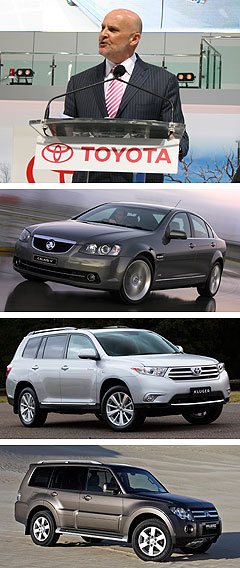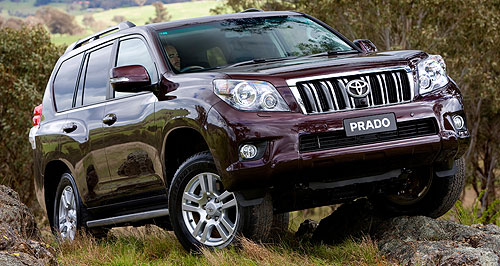Make / Model Search
News - ToyotaAbolish LCT, says Toyota, FCAITaxing times: Toyota's LandCruiser is deemed Australia's second best selling luxurious vehicle under Luxury Car Tax rules. Toyota joins industry calls for the elimination of Luxury Car Tax as rorts emerge22 Jun 2011 TOYOTA Australia has joined the industry chorus for the abolishment of Luxury Car Tax (LCT) following recent reports of evaders using a loophole to rort the system. The Australian National Audit Office (ANAO) report that revealed the existence of LCT evasion when it was published last month also contained a list of the top ten most popular vehicles subject to LCT in 2010. FCAI chief executive Andrew McKellar told GoAuto that Toyota’s stand “reflects a very strong view across the industry that the LCT desperately needs to be reformed”. The top two most popular vehicles – which under LCT rules are deemed luxurious if they cost more than $57,466 (or $75,375 if their average fuel consumption is 7.0L/100km or less) were not exclusive European vehicles, but Toyota’s Prado and LandCruiser off-roaders. “Toyota is Australia’s number one luxury car brand according to the Luxury Car Tax regime”, joked Toyota Australia senior executive director for sales and marketing David Buttner in a press release attacking the controversial tax this week. Other supposedly luxurious vehicles included in the LCT top ten were the Holden Commodore (ranked third), Mitsubishi Pajero (fifth) and Toyota Kluger (eighth). Premium-branded European cars predictably made up the rest of the table, represented by the Mercedes-Benz C-class (fourth), BMW 3 Series and X5 (sixth and seventh) Audi A4 (ninth) and Mercedes-Benz M-class (tenth). Mr Buttner, who described the LCT as discriminatory, inefficient, punitive and poorly designed, said Toyota wanted to see the tax abolished or at least “fundamentally reformed to feature a more realistic threshold and to exclude low emissions vehicles”. Ironically, Mr Buttner’s suggestion would see Prado and LandCruiser buyers remain subject to high taxes, given the Prado’s CO2 outputs of between 219 and 306g/km and the LandCruiser’s 273-341g/km carbon footprint. Under a sliding-scale CO2-based taxation regime, the Ferrari California HELE (275g/km) and McLaren MP4-12C (279g/km) – which both attract an LCT slug in excess of $90,000 – would incur less tax than some Prado and LandCruiser variants. On the other hand, efficient European luxury cars like the new Mercedes-Benz C250 CDI, which delivers strong performance (0-100km/h in 7.1 seconds) while sipping fuel at the rate of 5.1L/100km and producing just 134g/km of CO2, should become more affordable. Mr McKellar believes the LCT “is providing a discouragement to the take-up of advanced safety and environmental technologies,” a practice that “should not be a feature of the tax system in Australia”. Asked whether the FCAI was supportive of an emissions-based tax to replace LCT, Mr McKellar said: “We don’t want to just replace one bad tax with one that’s not well-designed.” He said the FCAI’s preferred approach to LCT was abolition, as recommended in the 2010 Henry taxation review. “When you consider that the government’s proposed policy is to introduce a carbon price across the board we need to proceed with caution in regards to applying another layer of tax on top of that. “We will look constructively at any option that leads to reform and a better policy outcome. That includes environmentally-based alternatives.” Toyota also hit out at the fact that accessories fitted at the time of purchase are included under the LCT regime. Mr Buttner cited the example of bull bars and tow bars often fitted to four-wheel drives.  “No other consumer product has an additional tax applied simply because the value of the product exceeds an arbitrary threshold,” said Mr Buttner (left). “It is a tax people have to pay in addition to GST, stamp duty and registration fees when buying a new car. On top of that they pay tax on the fuel they use in their cars.” The ANAO report also revealed the findings of a 2008 audit carried out within the South Australia motor vehicle industry, in which some luxury car buyers were seen to evade LCT. The scam involves posing as a car dealer, quoting an ABN at the time of purchase and claiming to be holding the vehicle as “trading stock” in order to defer payment of LCT, which is charged only on the portion of a vehicle’s purchase price that exceeds the LCT thresholds. The tax evader then uses the car personally for two years until the LCT liability expires, at which point the car can be sold without paying the tax. An investigation by the Australian Financial Review found that for $468 the scammers can easily obtain a wholesale car dealer’s license from their local office of fair trading in order to “boost their credentials”. A Porsche-driving Perth businessman not connected with the car industry told GoAuto that his accountant had performed the tax dodge and advised him to do the same on his next car purchase. “Apparently you just need to go on a one-day course to get your dealer’s license,” he said. “It doesn’t cost much and you can save thousands. LCT is such a rort that I wouldn’t feel bad about not paying it”. The Australian Financial Review investigation also suggested that some corruption on the part of dealers supplying cars to tax-evaders could play a part. Trivett Classic executive chairman Greg Duncan was quoted as saying that many premium brand dealers were contractually prohibited from reselling cars to unauthorised dealers and that each had a moral obligation to check the “bona fides” of customers claiming to be wholesalers. Mr McKellar agreed that the system is open to abuse and that its apparent unfairness was a contributor. “There are some intrinsic weaknesses in the system,” he said. “A reflection of that is a significant distortion in the marketplace and the reality is that in many cases law-abiding citizens who comply with the law are the ones who get screwed over.” According to the ANAO, of 1692 tax-payers registered for LCT since the levy was introduced in 2000 only about 1000 regularly make LCT payments – and 84 per cent of the LCT collected annually is paid by the top 100 LCT payers. The LCT represents just 0.15 per cent of the treasury’s annual revenue and is therefore an income source deemed low-risk in terms of evasion, with commensurate levels of enforcement. The ANAO reports that the Australian Tax Office (ATO) does not actively manage the status of LCT-registered tax-payers and does not “undertake analysis of why a tax-payer may register for LCT and then not make a payment”. In addition, a business “with no prior or current dealings in motor vehicle sales” can register for LCT and LCT legislation only requires a tax-payer to have ABN and GST registration in order to register for LCT. Further, the ATO “does not apply any additional measures to verify the registration”. In 2008 – when the tax was raised from 25 per cent to 33 per cent and the threshold raised to $75,000 for vehicles bettering fuel efficiency of 7.0L/100km – the team established for the monitoring and planning of the LCT was disbanded. The ANAO report recommends that better planning and reporting process would make the LCT easier to administer without placing a heavy demand on existing ATO resources. “The ATO appears not to spend much time or resource seeking to administer and ensure effective compliance (of LCT) because it is not cost-effective to do so,” said Mr McKellar. “The result is you end up with a broken tax working less effectively and less fairly than it would in other circumstances.” LCT has attracted criticism since it was introduced along with the Goods and Services Tax (GST) at the beginning of this century. Few countries impose such a tax and even fewer demand such a high percentage. For example, the Canadian province of British Columbia levies a 2-3 per cent luxury tax rate, as does Pakistan. The 2010 Henry taxation review recommended the abolition of LCT – the only Australian tax imposed on goods or services deemed luxurious – labelling it as “arbitrary in its impact”. “It falls on people with a preference for relatively expensive cars, but not on those with a preference for diamonds, fur coats or yachts,” it said. “In the current Australian context, a tax on luxury cars is not a desirable means of raising revenue. It discriminates against a particular group of people because of their tastes. It is not an effective way of redistributing income from rich to poor. Its design is complex and becoming more complex over time.” LCT is a contributor to Australians paying some of the world’s highest prices on luxury cars. However, even with the tax subtracted, the price of many high-end cars still far exceeds that paid by European or US customers - once import duty, GST and dealer delivery fees are factored in. The smaller proportion of right-hand drive vehicles built globally and Australia's relatively small sales volumes also reduces the economy of scale with which car-makers can reduce manufacturing cost and importers can amortise shipping, pre-delivery, promotional, after-sales and other administrative costs. Importers also blame Australia’s steeper premium model prices on relatively high local design rule certification costs and the fact the many sportscars and luxury vehicles are more highly specified as standard in Australia than in the US or Europe.  Read more10th of June 2011  First Ferrari FF arrives Down Under – and then leavesFirst local look at Ferrari's AWD four-seat FF super-coupe as Oz pricing confirmed18th of May 2011  Porsche Panamera fuel-saving tyres to cost extra‘Green’ tyres to save Porsche Panamera S Hybrid buyers more than $500011th of May 2011  Car FBT 20 per cent flat rate ‘a tax grab’New flat-rate fringe benefit tax rules for cars to be phased in over four years10th of May 2011  Tax breaks timing to skew car market: FCAIDrought then spike in vehicle sales forecast for next year as tax breaks kick in21st of February 2011  Luxury car buyers switch to diesel powerBMW, Audi reach record diesel sales in 2010 |
Click to shareToyota articlesResearch Toyota Motor industry news |









Facebook Twitter Instagram